Collaboration with Maija Laurinen
Stone, pigment, programmed light, sound
Gallery Fikka, Porvoo Art Hall, Porvoo, Finland, 2025
The Blast, XXVVIII Mänttä Art Festival, Mänttä, Finland, 2024
Beyond Everything, Haihatus Art Center, Joutsa, Finland, 2023
Pimento, Oulu, Finland, 2021
Czinege & Laurinen explore intricate phenomena between perception, reality and the perceiver. At the centre of their site-spedific and time-based installation, ≡ ~~Double Negative, a stone acts as a sonde to what falls beyond means of direct human perception.
Czinege and Laurinen make space for perspectives that challenge the human-centric and often routine-like ways in which we interpret reality. Yet, ≡ ~~Double Negative doesn’t disclose what is happening. The sensation of blue is transparent, a stone turns into a fragile perceptual event. Low sound waves travel through matter, a shadow radiates light.
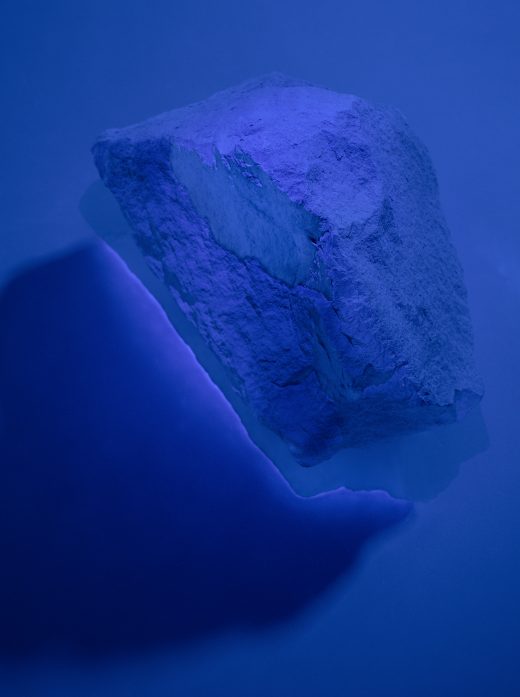
XXVIII Mänttä Art Festival, 2024. Photo: Marko Marin
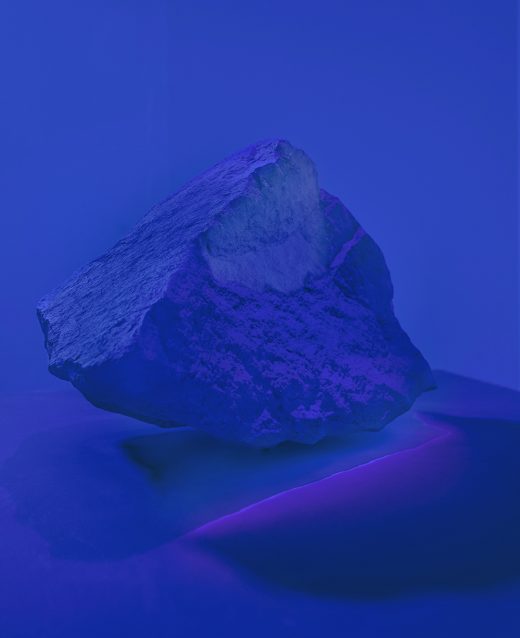
XXVIII Mänttä Art Festival, 2024. Photo: Marko Marin
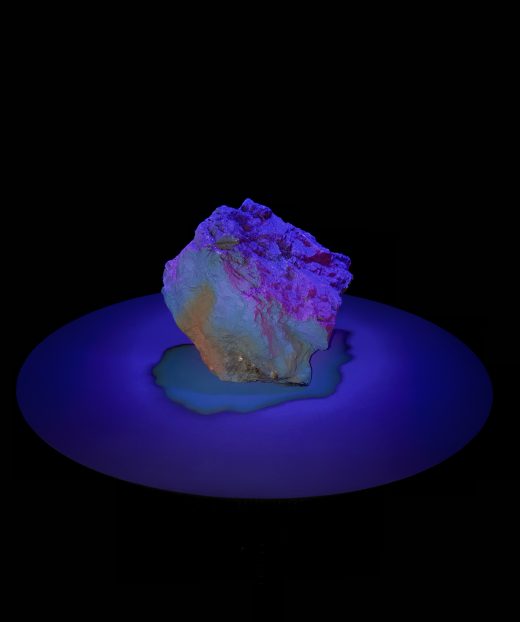
Pimento, Oulu, Finland, 2021
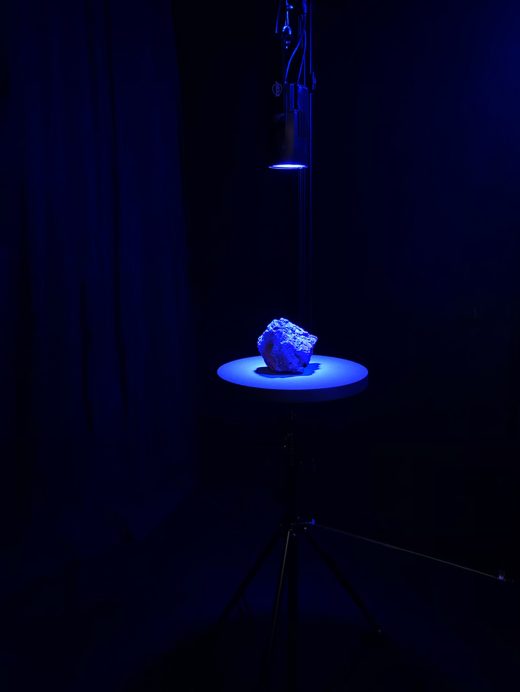
Pimento, Oulu, Finland, 2021
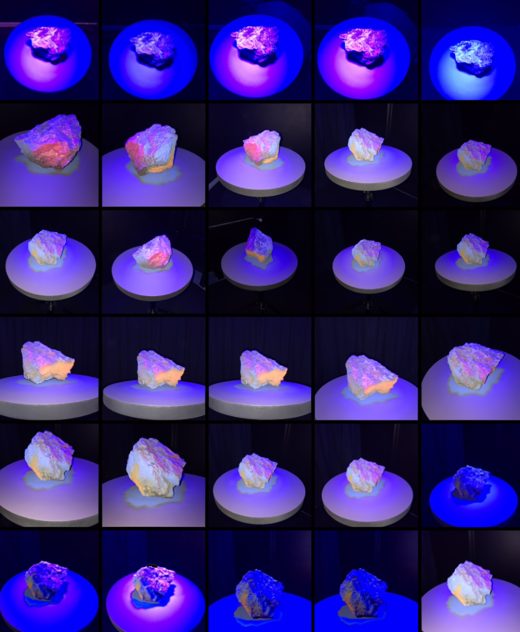
Maija Laurinen & Michal Czinege — Double Negative
Text by John Gayer – In Vlna Magazine, 2/2022
At first glance Double Negative recalls the dramatic style of presentations used in the display of many sculptures. They rest on plinths and are illuminated to stand out from the significantly darker environment that surrounds them. But noticing how Double Negative differs from that approach, immediately nullifies that impression. Lingering inside the black box gallery in which Maija Laurinen and Michal Czinege’s elegant work is set not only provides an extraordinary example of the interaction between light, material and space, but also shows how appearances can change. The circumstances of their durational installation, which comprises just a few components (a natural stone, some acrylic paint, a circular shelf support and an LED light situated above the stone), permit viewers to revel in a remarkable visual phenomenon that seems to defy explanation.
What surprises is the degree to which the appearance of this cauliflower-sized chunk of rock will change. In addition to changing colour, aspects of its surface features and jagged contour are affected. There are instances when its surface seems more chiselled and less so at other times. While bathed in a blue light, the stone presents a narrow range of bluish tones and looks quite frigid — as if it had just arrived from the dark side of the moon. The intensity of the light reflected from its surface, which is strongest on top, also gradually diminishes between there and its base. While its uppermost surface exhibits the palest silvery blues and the sides are blanketed in deep cobalt, the most cavernous hollows, its underside and the shadow cast on the platform on which it sits all read as dense midnight blue. In fact, the stone’s shadow appears so dark, one can see it as a crater out of which the object may have just emerged.
The confined space of Pimento’s black box gallery not only intensifies a captivating transition that occurs gradually and ranges from a monochromatic array of blues to one that is kaleidoscopic, but it also underlines the work’s magical aura. This promotes close observation and generates questions as to the source of the phenomenon. The attentive viewer will notice there is only one agent that causes the transitions, and it is the light. Small shifts in its wavelength only detectable from very slight changes in the light’s colour triggers the chromatic diversity.
So, what else plays a role in causing the stone’s surface to shift from the blues, at one extreme, to its highly variegated appearance at the other? When metallic versions of magenta, tangerine, violet, olive, lavender-turquoise and sunset orange enliven the stone’s surface in its kaleidoscopic phase, its more ethereal shadow is made of such complementary hues as cobalt, sage green and indigo. According to the artists, the stone’s appearance is influenced by its mineral content and light applications of acrylic paint. Though knowing this does not explain what physical mechanisms are taking place, it does provide clues as to the object’s general mottled appearance and why the peaks of a craggy area might be one colour, while another colour defines the troughs between them.
Moreover, the luminescence of the stone’s surface recalls scientific methods of analysis that exploit the ways materials will respond to specific kinds of light. Considering that in their exhibition statement, Laurinen and Czinege say that Double Negative acts as a ‘sonde’ implies such a relationship. A sonde is type of probe that relays data from difficult to access places. They enable information to be gathered from the upper atmosphere, below the earth’s surface, underwater and in the body — virtually any remote location. This begs the question: What are we to conclude from the behaviour the stone’s surface in this light?
Though the work provides no quantitative data, it does urge viewers to consider multiple potential connections. As a durational installation, the most obvious consideration is its relationship to time. Encompassing time in its cyclical and linear forms, it simultaneously highlights recurring processes and the brevity of the present. And while the transitions that alter the stone’s appearance could be documented and then subdivided into increments that are only fractions of a second long, the stone itself prompts meditation on the conditions needed to generate such matter and cause its deterioration. That means time must be considered on a geological scale. Other thoughts that come into play involve light’s particle-wave duality and how this form of energy may be absorbed, transmitted, reflected and/or refracted by different materials.
Additional questions raised by the inherent contradictory concept projected by the title further influence the installation’s interpretation. While many know that combining two negative values produces a positive result in mathematics, the fact that two negative statements can have a positive or a negative meaning in verbal communication can be confusing. Confusion also arises in relation to colour mixing. For example, when all colours — or wavelengths — of the visible spectrum are added together, the white light that results from this additive process can feel more like a negative outcome. But with paint, the opposite seems to happen. Since paint reflects less and less light as more and more colours are blended, the decrease in colour reflectance is a subtractive process.
An accompanying text by Laurinen calls attention to additional examples of seemingly inconsistent phenomena. Though not a poem in the strictest sense of the term, her words have a poetic ring. These words do more than underline the magical impressions and sense of inconclusiveness the installation generates; they amplify its impact by contributing a pronounced atmosphere of wonder. Hence, this excerpt:
There is movement
where you thought everything stands still
and perfect stillness
when you travel fast enough.
If light and darkness are
of one and the same void,
there is light when you stand
in the shadow of the Earth,
and there is darkness
where you seek infinite light.
With respect to Double Negative, Laurinen’s words highlight the antithetical aspects of experience and the transitional stages that link them. While the work’s evolving appearance has been documented in a series of installation views, which enables one to evaluate various stages in the progression, they also indicate that each forms one facet of a diverse whole. Moreover, the fact that viewers can become totally absorbed in this chromatic display — prolonged observation only strengthens its fascinating presence — attests to the installation’s inherent power. In its own quiet way, the work speaks of the rather cryptic and phenomenal nature of the world in which we live. These are things that, since they tend to be trounced by day-to-day affairs, are readily forgotten.
Working independently, Maija Laurinen and Michal Czinege have produced intelligent and visual rich artworks and installations that push viewers to question what they are seeing. Laurinen, in projects such as Nightworks of John Deere (2015), What Do We See When We See Dark Things? (2018/2019) and If and Only If (2020), has explored visual phenomena observed through various types of diaphanous screens, in low light level situations and via an interplay of light and shadow made by using a combination of transparent, translucent and reflective materials. Czinege has integrated painting with installation art to produce Model for Fading Shadows (2016) and Behind the Moon (2018), works which challenge our understanding of shadows, especially how they look or where we expect them to appear, and structures, such as Deep Breath (2021), which refer to architectural spaces and, in this case, is animated by a slowly pulsing light. Although Laurinen and Czinege’s collaborations have been infrequent, Double Negative proposes that more would be justified.